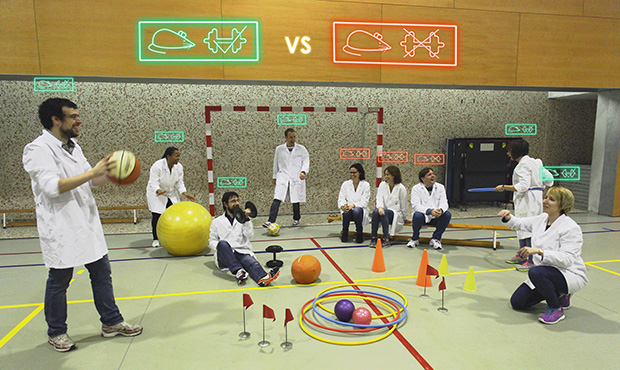Core Facilities
Researchers from the CRG demonstrate, for the first time at a molecular level, how regular exercise improves cardiac cell function.
It is nothing new to say that doing sport regularly is good for your health. We know that physical exercise reduces our risk of heart problems, having high cholesterol, hypertension, and some studies even suggest that working up a sweat helps fight the risk of cancer. In fact, recently, the World Health Organisation included physical activity among its recommendations for avoiding tumours.

It is also known that playing tennis, running, swimming and riding a bike stimulate the immune system, improve our mood, and even give our nerves a good massage and can prevent the appearance of Alzheimer’s.
However, although the ancient Greeks understood Mens sana in corpore sano, a healthy mind in a healthy body, and science had proved this to be true, until now, no-one knew what was happening at the molecular level to produce these benefits. In fact, it was in some ways, a mystery.
Now it seems that a team of researchers, including the Proteomics Unit from the Centre for Genomic Regulation, have found part of the answer. In a study published in the Journal of Proteome Research, the American Chemical Society (ACS), shows that doing sport in a sustained way modulates the cells’ energy factories, the mitochondria, by regulating their protein activity.
Mice sweating bullets
The CRG researchers, led by Eduard Sabidó, head of the centre’s Proteomics Unit, worked in collaboration with a Portuguese team from the Department of Physiology and Cardiothoracic Surgery in the Faculty of Medicine at the University of Porto, thanks to the European project PRIME-XS. The multidisciplinary scientific team was interested in finding out what makes individuals who do sport have a different energy metabolism to those who lead a sedentary life. To do this, first they ran a 54-week experiment on rodents that they divided into two groups: one group underwent regular training that made them run on a typical wheel, while the other did no kind of exercise.
Then the CRG researchers analysed mitochondrial proteome samples from muscle tissue and characterised the differences they observed between the cardiac cells of fit and sedentary mice. They found that the proteins of “athletic” mice contained a series of modifications related to energy production in the cell.
“We found that animals which did sustained exercise presented alterations in some of their proteins. Using bioinformatics tools, we analysed what these modified proteins had in common, and in which cellular processes they were involved. From this analysis we defined which proteins were responsible for modulating the changes and therefore regulating the activity of the other mitochondrial proteins”, explains Eduard Sabidó.
For the analysis they measured the proteins found in the mitochondria, as this is the main organelle in charge of cell metabolism, in other words, it is effectively the cell’s energy factory. Previous studies had already highlighted the importance of the organelle in this type of physiological modulation. The CRG researchers were able to identify two proteins, a type of kinase known as RAF, and p38, which appear to be directly involved in modulating the cardiovascular benefits of regular moderate exercise.
“All the proteins we have identified are related, to some extent, to how the cell manages its energy, and in animals that do sport routinely, this management is probably more efficient than in sedentary mice”, says Sabid.
Who gets there first?
The CRG research team was able to identify and quantify the modified proteins responsible for the cardiovascular benefits of sport using mass spectrometry. This is an analytical technique that enables you to weigh peptides and proteins, and therefore characterise them. Basically, it is like using the kitchen scales at home to weigh the ingredients for a recipe, but thousands of times more accurate.
One of the ways this balance ‘measures’ the mass of the molecules is by counting the time it takes them to travel the distance between the balance input and the detector. Sabidó, head of the CRG Proteomics Unit, uses a metaphor to explain this: “Imagine there is a car, a motorcycle and a truck in Barcelona and they have to get to Madrid. We put a stopwatch in the second city to calculate how long it takes them to make this journey. Of course, the bike is smaller and able to dodge vehicles, so it arrives first, followed by the car, and finally the truck, which is bigger and heavier. The same applies to peptides and proteins: we throw them onto the scales and calculate the time it takes them to reach the detector; with this information we can infer the mass and, therefore, identify which protein it is and the quantity.”
Proteins are the molecules responsible for carrying out the cell’s functions, and with traditional molecular biology techniques it is difficult to use a single analysis to discover which proteins are in a cell, and in what quantity. “With microscopy you can observe a particular protein that you marked with a fluorescent label, but using mass spectrometry you can see 10,000 proteins simultaneously and quantify them in many samples and under different conditions”, explains Guadalupe Espadas, a mass spectrometry specialist at the CRG and co-author of the publication. This way, you can get an overview of the cell and observe the variations that make the proteins more or less active, or which mean they are located in one part of the cell or another.
Reference work
Ferreira R, Vitorino R, Padrao AI, Espadas G, Mancuso FM, Moreira-Gonçalves D, Castro-Sousa G, Henriques-Coelho T, Oliveira PA, Barros AS, Duarte JA, Sabido E and Amado F. “Lifelong Exercise Training Modulates Cardiac Mitochondrial Phosphoproteome in Rats”. Journal of Proteome Research. 2014 Jan 28. 13 (4): 2045–2055. http://dx.doi.org/10.1021/pr4011926